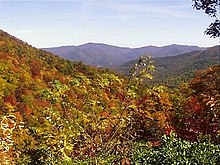Backwoods movie
The Backwoods film (German: "Hinterwäldler- / Hinterste-Provinz-Film") is an independent film genre , which is often seen as a sub-genre of horror films .
It includes a series of films, some of which are very different, whose common feature, according to the literary and media scholar Udo Franke-Penski, is that a group of average urban people (mostly teenagers) stray from the path in a wilderness and “from civilization to hell archaic past in which there is no law, no order and no protection, only violence, horror and the law of the fittest. If you want to survive this hell, you have to suppress the civilized part of your personality until the finale [...] and resort to the means of monsters - violence and mercilessness. ” As Weston Ochse already emphasized with regard to literary models, it doesn't have to change act as a special location, but merely an isolated, i.e. completely secluded place. For example, the film Urban Explorer (2011, director: Andy Fetscher ) could be counted as a Backwoods horror, even though the action does not take place in a forest, but in the tunnels and bunker systems below Berlin .
At least as a subgenre of horror films, the Backwoods film found its justification in 1974 with the film The Texas Chainsaw Massacre (1974, director: Tobe Hooper ), even if, for example, Calum Waddell in the film Spider Baby (1964, director: Jack Hill ) had an early forerunner sees. Looking back, earlier films like Two Thousand Maniacs! (1964, directed by Herschell G. Lewis ) and When Everyone is Dying (1972, directed by John Boorman ) is classified in this genre. After the success of Hoopers Chainsaw Massacre , numerous genre representatives have appeared to this day, the latest examples of which are films such as Wrong Turn (2003, directed by Rob Schmidt ) or The Hills Have Eyes (2006, directed by Alexandre Aja ). The explicit portrayal of violence in these newer films harbors transitions to so-called " torture porn ". Since then, backwoods films such as Eden Lake (2008, director: James Watkins ), Frontier (s) (2007, director: Xavier Gens ), Manhunt Backwoods Massacre (2008, director: Patrik Syversen ) or Backwoods - Die have also increased in Europe The Hunt Begins (2006, directed by Koldo Serra ). The motifs and iconography of the genre are the public now so familiar that in 2010 with Tucker & Dale vs. Evil (2010, directed by Eli Craig ) is a successful satire ( "a backwoods comedy" ) could appear on the genre.
Individual evidence
- ↑ Udo Franke-Penski: Chainsaws, Lust and Tolerance - On the Consumability of Horror Fictions. In: Benjamin Moldenhauer, Christoph Spehr, Jörg Windszus (Eds.): On Rules and Monsters - Essays on Horror, Film and Society. Hamburg 2008, p. 29f.
- ↑ Weston Ochse: Freaks and Fiddles, Banjos and Beasts - Writing Redneck Horror. In: Mort Castle (Ed.): On Writing Horror - A Handbook by the Horror Writers of America. Georgetown 2007, p. 179.
- ↑ Peter Osteried: Nothing new in the West. On: gamona.de (October 21, 2011)
- ↑ Udo Franke-Penski: Chainsaws, Lust and Tolerance - On the Consumability of Horror Fictions. In: Benjamin Moldenhauer, Christoph Spehr, Jörg Windszus (Eds.): On Rules and Monsters - Essays on Horror, Film and Society. Hamburg 2008, p. 29.
- ↑ Calum Waddell: Jack Hill - The Exploitation and Blaxploitation Master Film by Film. Jefferson 2009, pp. 18-20.
- ↑ Tim Anderson: Another Look at 'Tucker and Dale vs Evil. On: bloody-disgusting.com (March 23, 2010)
